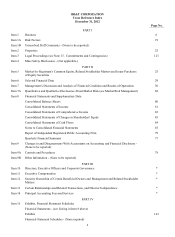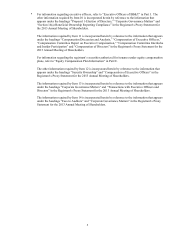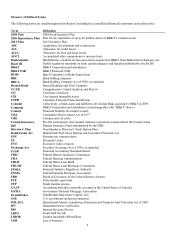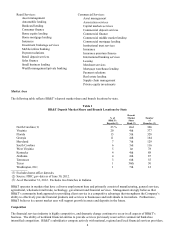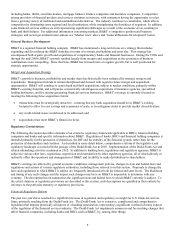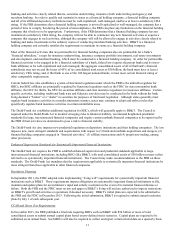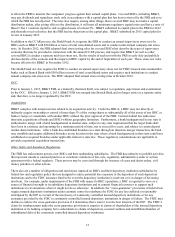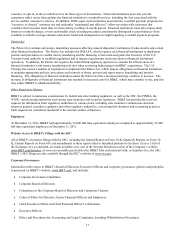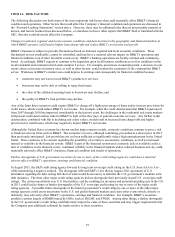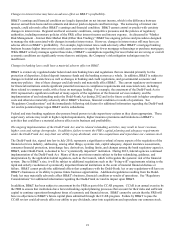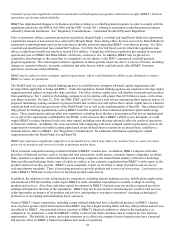BB&T 2012 Annual Report Download - page 34
Download and view the complete annual report
Please find page 34 of the 2012 BB&T annual report below. You can navigate through the pages in the report by either clicking on the pages listed below, or by using the keyword search tool below to find specific information within the annual report.
12
to allow the FRB to monitor the companies’ progress against their annual capital plans. Covered BHCs, including BB&T,
may pay dividends and repurchase stock only in accordance with a capital plan that has been reviewed by the FRB and as to
which the FRB has not objected. The rules also require, among other things, that a covered BHC may not make a capital
distribution unless, after giving effect to the distribution, it will meet all minimum regulatory capital ratios and have a ratio of
Basel I Tier 1 common capital to risk-weighted assets of at least 5%. BB&T submitted its capital plan to the FRB for 2012
and thereafter received notice that the FRB had no objections to the capital plan. BB&T submitted its 2013 capital plan for
review in January 2013.
In addition to the CCAR process, the Dodd-Frank Act requires the FRB to conduct an annual supervisory stress test for
BHCs such as BB&T with $50 billion or more of total consolidated assets and to conduct semi-annual company-run stress
tests. In October 2012, the FRB adopted final stress testing rules for covered BHCs that describe the types of supervisory
scenarios that may be provided in connection with the annual CCAR process, and require that BB&T (as well as other
covered BHCs) conduct a separate mid-year stress test, file the results of such test with the FRB in early July and publicly
disclose details of the scenario and the impact on BHC capital by the end of September of each year. These stress test rules
became effective for BB&T in November 2012.
The Dodd-Frank Act also requires the FDIC to conduct an annual supervisory stress test for FDIC-insured state nonmember
banks such as Branch Bank with $50 billion or more of total consolidated assets and requires such institutions to conduct
annual company-run stress tests. The FDIC adopted final annual stress testing rules in October 2012.
OCC
Prior to January 1, 2013, BB&T FSB, as a federally chartered thrift, was subject to regulation, supervision and examination
by the OCC. Effective January 1, 2013, BB&T FSB was merged into Branch Bank and no longer exists as a separate entity
and, therefore, is no longer regulated by the OCC.
Acquisitions
BB&T complies with numerous laws related to its acquisition activity. Under the BHCA, a BHC may not directly or
indirectly acquire ownership or control of more than 5% of the voting shares or substantially all of the assets of any BHC or
bank or merge or consolidate with another BHC without the prior approval of the FRB. Current federal law authorizes
interstate acquisitions of banks and BHCs without geographic limitation. Furthermore, a bank headquartered in one state is
authorized to merge with a bank headquartered in another state, subject to any state requirement that the target bank shall
have been in existence and operating for a minimum period of time, not to exceed five years; and subject to certain deposit
market-share limitations. After a bank has established branches in a state through an interstate merger transaction, the bank
may establish and acquire additional branches at any location in the state where a bank headquartered in that state could have
established or acquired branches under applicable federal or state law. These regulatory considerations are applicable to
privately negotiated acquisition transactions.
Other Safety and Soundness Regulations
The FRB has enforcement powers over BHCs and their nonbanking subsidiaries. The FRB has authority to prohibit activities
that represent unsafe or unsound practices or constitute violations of law, rule, regulation, administrative order or written
agreement with a federal regulator. These powers may be exercised through the issuance of cease and desist orders, civil
money penalties or other actions.
There also are a number of obligations and restrictions imposed on BHCs and their depository institution subsidiaries by
federal law and regulatory policy that are designed to reduce potential loss exposure to the depositors of such depository
institutions and to the FDIC insurance fund in the event the depository institution is insolvent or is in danger of becoming
insolvent. For example, under requirements of the FRB with respect to BHC operations, a BHC is required to serve as a
source of financial strength to its subsidiary depository institutions and to commit financial resources to support such
institutions in circumstances where it might not do so otherwise. In addition, the “cross-guarantee” provisions of federal law
require insured depository institutions under common control to reimburse the FDIC for any loss suffered or reasonably
anticipated by the DIF as a result of the insolvency of commonly controlled insured depository institutions or for any
assistance provided by the FDIC to commonly controlled insured depository institutions in danger of failure. The FDIC may
decline to enforce the cross-guarantee provision if it determines that a waiver is in the best interests of the DIF. The FDIC’ s
claim for reimbursement under the cross-guarantee provisions is superior to claims of shareholders of the insured depository
institution or its holding company but is subordinate to claims of depositors, secured creditors and nonaffiliated holders of
subordinated debt of the commonly controlled insured depository institution.


